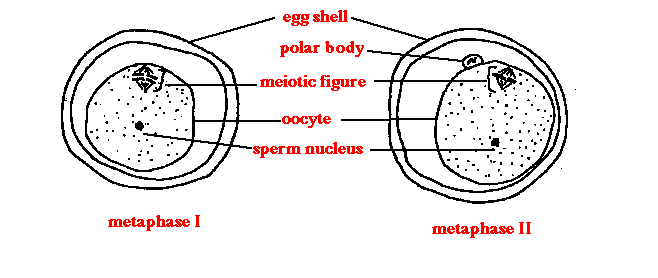
Meiosis in a Diplontic Life Cycle
(Canadian Campbell 2nd ed - Concept 13.2)
The diplontic life cycle is that which is characteristic of animals. The stages in the development of the gametes in animals, gametogenesis, occurs in the testis in the case of the sperm and in the ovaries or oviducts in the case of the egg. In this exercise the maturation of the egg will be studied as it occurs in the parasitic roundworm Ascaris. Since the diploid number of chromosomes is only four in Ascaris megalocephala, the worm is ideal for the study of oogenesis.
The reproductive organs in Ascaris are long, highly coiled tubes, which are regionally divided into the ovary, oviduct and uterus. Various stages of meiosis and development occur serially along the uterus.
Again, the advantage of using Ascaris to study meiosis is in the small number of chromosomes (2n = 4) for Ascaris megalocephala. An unusual feature of Ascaris meiosis is that the sperm which is amoeboid and non-flagellated penetrates the primary oocyte prior to meiosis taking place in the oocyte. The sperm nucleus remains visible in the oocyte as meiosis proceeds and eventually fuses with the final egg nucleus to produce the zygote. Immediately after zygote formation the initial mitotic divisions occur.
Click to View:

- How many chromosomes are present at metaphase I? Metaphase II?
- How many chromosomes does the sperm nucleus have?
- What important event occurs at metaphase I?
First published Sept 95: Modified June 2020
Copyright © Michael Shaw 2019 (Images and Text)
![]() Back
to Lab Index
Back
to Lab Index ![]() University
of Manitoba Home
University
of Manitoba Home